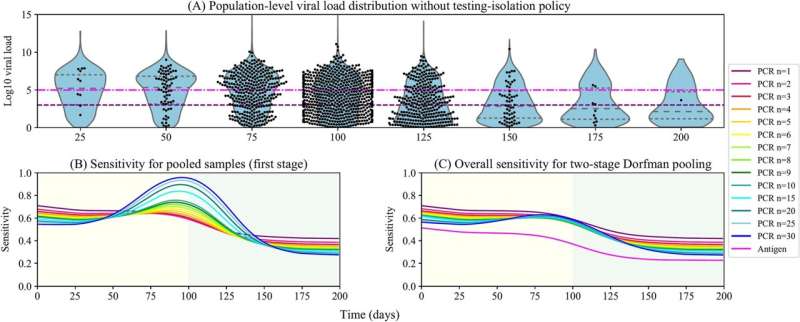Frequent population screening can contain COVID-19

In the face of the escalating fifth wave outbreak in Hong Kong, the government is planning a universal population screening that will combine antigen tests and PCR tests.
A recent study by researchers from the Tsinghua-Berkeley Shenzhen Institute, the University of California Berkeley, and the University of Hong Kong (HKU) revealed that frequent population screening, facilitated by pooled PCR(Polymerase chain reaction) and antigen testing, can effectively reduce total infections and potentially end the transmission of SARS-CoV-2, especially in low disease prevalence areas.
The findings were published in the open-access academic journal Scientific Reports. The results will also provide insights on how population screening could be implemented in the city.
Individual PCR testing is the most accurate method but is costly. The Dorfman pooling method is widely used as a more cost-effective method. It works in a two-stage operation. Specimens from multiple individuals are pooled together to be tested as one sample in the first stage. Then only samples showing a positive result are re-tested individually to identify the infected specimen.
Such population screenings play a substantial role in safely reopening economies and avoiding outbreaks. For example, China has adopted pooled PCR screening as a regular tool to screen individuals with no symptoms until community transmission ends. Shenzhen, a city of more than 17 million people, conducted two rounds of city-wide population screening, five rounds of screening in Yantian District, and four rounds of screening in Bao'an District by PCR-based Dorfman pooling between May and June 2021 to successfully end the resurgence of COVID-19.
This study has evaluated the feasibility and cost-effectiveness of pooled PCR and antigen testing by simulating the virus transmission process at an individual-level in a community of 100,000 residents with the COVID-19 strains in early 2021 as the basis. Although antigen tests are less sensitive, they help provide quick results.
The findings highlighted that the frequency, turnaround time, and initial prevalence significantly impacted the cost-effectiveness of population screening.
High-frequency screening can reverse the COVID outbreak
The findings revealed that frequent testing is critical for the success of population screening.
In the model, assuming an initial prevalence of 0.1%, i.e., a very small proportion of the population is infected, a reproductive number (number of people infected by a single infected person) of 2.5, and a participation rate of 90%, simulations showed repeated population screening every three days, using pooled PCR tests or antigen tests, could eliminate community transmission within two to three months.
Lower-frequency screenings could only partially mitigate the outbreak, but not terminate it. An antigen screening every 14 days would see 50% of the population eventually getting infected.
Pooling multiple samples together can help save resources. A large pool size can be considered for first-stage testing if the prevalence is lower than 0.1%, speeding up the process by removing and isolating infected individuals from the transmission chain. As prevalence increases, a smaller pool size should be adopted to single out the positive cases—which is more accurate but may lead to a longer turnaround time for one round of screening.
"To stop an exponential growth of infections, the testing frequency should at least bring the effective reproductive number below 1. The higher the reproductive number, the more frequent the testing to contain the spreading," said Yu Jiali, co-author of the study and a researcher from the Tsinghua-Berkeley Shenzhen Institute (TBSI).
"High-frequency tests can quickly identify infected individuals and reduce the prevalence. As prevalence decreases, the optimal pool size of PCR tests will increase, and the testing frequency can be further increased," said co-author Huang Yiduo, a researcher at the Department of Civil and Environmental Engineering of the University of California Berkeley.
What this means for Hong Kong
"Hong Kong will need to adopt a smaller pool size in PCR screening in view of the relatively high prevalence rate. The combination of daily antigen screening will expedite the pooled PCR screening as the prevalence decreases with proper isolation of those infected," said Professor Max Shen, corresponding author of the study and the Vice-President (Research) at HKU.
The current testing capacity of Hong Kong is estimated to be about 300,000 single tubes per day following the installation of the Fire Eye laboratory. This is expected to rise to 700,000 single tubes per day by mid-March with mobile laboratories from the mainland, which will help test 3.5M people in one day if five samples are pooled for first stage testing.
Currently, rapid antigen tests are used by the general public and the government to tentatively identify positive cases, which allows for early isolations of those infected. It hopefully can suppress the outbreak and lower the prevalence before the population screening.
At the time of screening, assuming a prevalence of 2% to 5% active infection cases among Hong Kong's population, it would take 4 to 5 days to complete the first round of PCR screening, as per the simulation. Professor Shen added that a prevalence rate below 2% would allow a pool size of 10 samples through which one round of screening will only take two to three days.
The research team suggested population screening to be conducted as soon as possible at an early stage of the outbreak to identify and isolate the positive cases. In mainland China, the central government has mandated cities to carry out at least three rounds of population screening amid high-risk community transmissions. Mainland cities with a population of less than 5 million have to complete PCR screenings within 2 days, while for a population of 5 million or more, the aim is within three days. The largest pool size of PCR tests allowed is up to 20 samples in case of limited resources.
More information: Jiali Yu et al, Optimizing and evaluating PCR-based pooled screening during COVID-19 pandemics, Scientific Reports (2021). DOI: 10.1038/s41598-021-01065-0





















